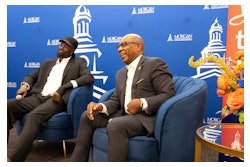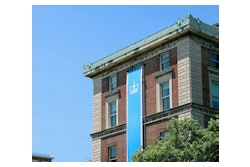We jodi men sonje demen
See today, but remember tomorrow … Creole proverb
GANTHIER, Haiti — Kindergarten students at the Village of Hope School marched happily into the schoolyard to begin their day serenading me and 10 others on the volunteer team from Northern Virginia by raising the Haitian flag and singing the island’s national anthem. The future of Haiti will be resting on the shoulders of these little ones someday.
Afterward, several members of the mission team visited with sponsored children. At noon on that last Thursday of February, older students joined the group for a lunch of rice and beans with fish sauce in the cafeteria.
After three days in Haiti, our team still had much work to do to get the health center ready for medical equipment. Some folks say there are only two seasons in Haiti — hot and hotter. Fortunately, the rainy season had not begun, so we were lucky only to have hot. Evenings were in the 70s but highs in the afternoon hit 95 degrees.
Returning to Hope House in the evenings brought some respite, but we were really looking forward to reconnecting with some orphans we first met in 2009.
The two visits re-energized us in the afternoons.
Marie Majors, received the mission team at her home, where she cares for 20 orphans. The facility, which was completed in 2009, received significant damage during the 2010 earthquake, yet her work continues in Croix-des-Bouquets.
“Parents don’t come to see their children,” Majors said. Gifts were brought from the adoptive parents of Journalda Nice for all of her former housemates to share.
The girls were just delighted to comb and to braid some of the ladies’ hair. Frisbees, bubbles and singing gave everyone the giggles.
Several orphans were entering their teens. When the girls age out of the orphanage, Majors said, the hope is that they will continue in state schools.
Moving on to the Little Children of Jesus sponsored by the Florida-based Food for the Poor organization, the mission team danced to the music provided by a staff member, who also is a disc jockey. Gladys Hugette and her staff care for more than 100 physically challenged children, and they were glad to receive diapers.
The team reconnected with several little ones from years ago and cuddled some new arrivals. Animal-shaped balloons tickled the fancy of many.
A first-timer to Haiti became seriously ill with parasites that Friday just 36 hours before the return to the States. Marilyn Newstrom made a quick recovery with some rest and antibiotics.
Unfortunately, she missed joining the mission team for a Saturday visit to the Apparent Project, a new artisans’ guild using discarded materials to create jewelry, journals and home décor. Employing Haitian women brings new hope to families, earning the means to pay for food, shelter and education.
“This means less crime, less stress and a whole lot more beauty,” said Shelley Clay, director. “We are trying to help mothers and fathers in poverty to be a parent to their children.”
A few tent cities and rubble remain in Port-au-Prince and Croix-des-Bouquets. However, a lot more farm animals (goats, cattle and chickens) were seen nearby as men and women planted corn and sugarcane in the parched earth.
The U. S. Agency for International Development estimates that its rubble-removing projects helped between 34,000 and 56,000 Haitians — about 10 percent of the total displaced population — return to their homes. The 2011 report also estimated 46,190 to 84,961 people had died in the quake.
In March 2011, eight members of the Haitian government completed a 15-day training program at the Treasure Coast Public Safety Training Complex at Indian River State College (Florida) to improve disaster relief and emergency management efforts. The members of the Ministry of Youth, Sports and Civic Action will themselves train up 60 young Haitians in the same skills. Altogether four teams were expected to train 1,000 Haitians to be first responders.
Meanwhile, Dr. Walter Bumphus, of the American Association of Community Colleges, is expected to conduct a survey to see which colleges are engaged in assisting Haiti. Since the temblor, AACU member institutions have been encouraged to provide scholarships for Haitian students.
“It also will be important to explore curriculum for future careers to help Haiti develop,” said Dr. Carole Berotte Joseph, president of Bronx Community Colleges. “Teachers and teachers’ assistants are a priority since 46 percent of the Haitian population is not getting educated.”
Agriculture is a dying sector, Joseph continued. “Training entry-level health workers, nurses, lab techs to fill understaffed positions is a priority.” Decentralizing the State University of Haiti with community colleges in addition to seamless transfer capabilities to four-year colleges will be key, according to Joseph.
Sitting next to a Haitian man on my Sunday afternoon return flight to Miami, one could only imagine his great sorrow, losing seven members of his family in the temblor. He was so grateful to hear that Americans were still coming to offer assistance … rebuilding wells, homes, schools and health facilities.
But so much more needs to be done.
A multimedia slide show is available on this website: https://www.flickr.com/photos/diverseedu/sets/72157629220101060/show/with/6982429327


















